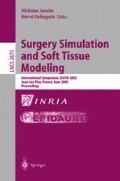Abstract
Surgery simulation is one of the largest applications of Medical Virtual Reality. In order to perform the real-time simulation, we constructed an elastic organ model known as a sphere-filled model. This proposed organ model allows us to perform surgical maneuvers such as pushing, pinching and incising and show the deformation of the inner structures such as blood vessels on our system. In addition, we tried to obtain haptic sensation with the patients’ organs in a surgical simulation. Developed system made it possible to handle elastic organs with two force feedback devices attached to the both of users’ hands. At the same time, we have been developing a VR cockpit suited for virtual surgery and tele-surgery. Using our VR cockpit, our system allows us to provide the users with an environment closely resembling the open surgery situation.
Access this chapter
Tax calculation will be finalised at checkout
Purchases are for personal use only
Preview
Unable to display preview. Download preview PDF.
References
JM. Rosen, H. Soltanian, RJ. Redett, D.R. Luab, “Evolution of Virtual Reality,” IEEE Engineering in Medicine and Biology, 1996, pp.16–22.
Robb RA, Camerson B. “Virtual Reality Assisted Surgery Program,” Interactive Technology and the New Paradigm for Healthcare, Eds. R. Satava, et al., Vol.18, 1995, pp.309–321.
[3] A. Norton, G. Turk, B. Bacon, J. Gerth, and P. Sweeney. “Animation of fracture by physical modeling, ” The Visual Computer, Vol.7, 1991, pp.210–219.
Robb RA, Hanson DP. “The ANALYZE software system for visualization and analysis in sugery simulation, ” Computer Integrated Surgery, Eds. Steve Lavalle, Russ Taylor, Greg Burdea and Ralph Mosges, MIT Press, 1995, pp.175–190.
H. Delingette, “Simplex Meshes: a General Representation for 3D Shape Reconstruction,” Technical Report 2214, INRIA, Sophia-Antipolis, France, 1994.
S. Cotin, H. Delingette, J. Marescaux, “Geometric and Physical Representations for a Simulator of Hepatic Surgery,” MMVR4, 1996, pp.139–151.
T. Ezumi, N. Suzuki, A. Takatsu, T. Kumano, A. Ikemoto, Y. Adachi, A. Uchiyama. “An Elastic Organ Model for Force Feedback Manipulation and Real-time Surgical Simulation,” International conference on artificial reality and telexistence, 1997, pp. 115–121.
S. Suzuki, N. Suzuki, A. Hattori, K. Sumiyama, S. Wakai, A. Uchiyama. “Deformable organ model using the sphere-filled method for virtual surgery,” World Congress on Medical Physics and Biomedical Engineering, 2000, 27(6), CD-ROM 5368-91825.pdf.
N. Suzuki, A. Hattori, T. Ezumi, A. Uchiyama, T. Kumano, A. Ikemoto, Y. Adachi, A. Takatsu. “ Simulator for virtual surgery using deformable organ model and force feedback system,” MMVR6 1998, pp.227–233.
N. Suzuki, A. Hattori, S. Suzuki, T. Kumano, A. Ikemoto, Y. Adachi, A. Takatsu. “Performing virtual surgery with a force feedback system,” The eighth international conference on artificial reality and telexistence, 1998, pp.182–187.
N. Suzuki, A. Hattori, S. Suzuki, K. Sumiyama, S. Kobayashi, Y. Yamazaki, Y. Adachi, “Collaborated surgical works (Surgical planning) in virtual space with tactile sensation between Japan and Germany,” MMVR2001, 2001, pp.479–484.
S. Wakai, N. Suzuki, A. Hattori, S. Suzuki, A. Uchiyama. “Real-time volumetric Deformation for Surgical Simulation using Force Feedback Device,” MMVR11, 2003, pp.386–388.
S. Suzuki, N. Suzuki, A. Hattori, A. Uchiyama. “Dynamic Deformation of Elastic Organ Model and the VR Cockpit for Virtual Surgery and Tele-surgey,” MMVR11, 2003, pp.354–356.
Author information
Authors and Affiliations
Editor information
Editors and Affiliations
Rights and permissions
Copyright information
© 2003 Springer-Verlag Berlin Heidelberg
About this paper
Cite this paper
Suzuki, N., Suzuki, S. (2003). Surgery Simulation System with Haptic Sensation and Modeling of Elastic Organ That Reflect the Patients’ Anatomy. In: Ayache, N., Delingette, H. (eds) Surgery Simulation and Soft Tissue Modeling. IS4TM 2003. Lecture Notes in Computer Science, vol 2673. Springer, Berlin, Heidelberg. https://doi.org/10.1007/3-540-45015-7_15
Download citation
DOI: https://doi.org/10.1007/3-540-45015-7_15
Published:
Publisher Name: Springer, Berlin, Heidelberg
Print ISBN: 978-3-540-40439-2
Online ISBN: 978-3-540-45015-3
eBook Packages: Springer Book Archive

